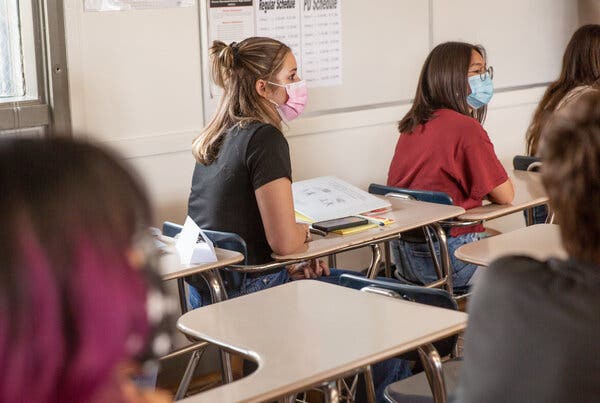
The Centers for Disease Control and Prevention said on Friday that unvaccinated students exposed to the coronavirus no longer need to miss school if they repeatedly test negative for the virus in the days after, allowing them to remain in class and school activities.
The new guidance, known as the “test to stay” protocol, would ease the burden on children who have been expected to stay home if a close contact tests positive for the virus, and on parents who have had to scramble to retrieve children from school or find day care.
Although some schools and districts are already using the approach, the C.D.C. has not previously endorsed it, citing a lack of evidence. On Friday, the agency released studies from two counties, one in Los Angeles and the other in Illinois, that effectively tested the test-to-stay protocol and found that it worked.
The studies were conducted before the fast-moving Omicron variant began spreading in the United States. Scientists are still investigating many basic questions about the variant, some of which could affect the assessment of in-school transmission risks.
The policy, hinted at in the winter Covid-19 plan that President Biden unveiled earlier this month, still calls on students to wear masks and socially distance, and applies only to those who remain asymptomatic as they test for the virus. Until now, unvaccinated students were expected to quarantine at home for as long as two weeks after exposure.
Vaccinated students with exposures have generally been allowed to remain in school as long as they are asymptomatic and wear a mask. The C.D.C. recommends that vaccinated people get tested five to seven days after close contact with someone who has a suspected or confirmed case of the virus.
The agency on Friday released studies from two counties, one in Los Angeles and the other in Illinois, that effectively tested the test-to-stay protocol. In Los Angeles, students at schools that did not participate in the pilot program, and who had to quarantine, lost an estimated 92,455 in-person school days between Sept. 20 and Oct. 31, while students exposed to the virus in schools trying out the program lost no days. Schools that used test-to-stay also did not see increases in virus rates among students.
In Lake County, Illinois, where the other study took place, researchers estimated that up to 8,152 in-person learning days were saved between August and October in schools that participated in the program. Of the 16 students in the program who tested positive for the virus in the two weeks after exposure, none appeared to transmit it to others at school, the report said.
The California students were tested twice in the week after exposure; the Illinois students were tested four times.
Dr. Rochelle P. Walensky, the C.D.C. director, said at a White House news conference on Friday that the protocol was “promising” and “now proven.” She added that because “test to stay” was only studied in schools, the C.D.C. did not yet have evidence about its effectiveness in other settings.
Public health experts cheered the move, saying it struck the right balance between keeping children safe and allowing them to continue with in-person learning.
“The test-to-stay programs are really good at balancing the costs and benefits,” said Zoe McLaren, a health policy expert at the School of Public Policy at the University of Maryland, Baltimore County. She added, “What the test-to-stay program does is help us keep Covid cases down, while also trying to make sure we keep kids in school as much as possible, which I think is really important.”
Research suggests that the risk of in-school transmission is relatively low when schools take a variety of precautions, including requiring masks and improving ventilation. But that research, like the two studies the C.D.C. released on Friday, was conducted before the Omicron variant emerged.
Still, new strategies for keeping children safe without shutting down schools or classrooms are needed, Dr. McLaren said.
“As the pandemic continues to morph, we need to think really carefully about how we’re using the long quarantines,” she said. “And quarantining kids that have a low risk of exposure or a low risk of transmission — we really need to think about the trade offs that are involved there.”
Allowing children to stay in school is also good for parents, she noted, allowing them to stay at work. “It’s just much less disruptive, which I think we need to be thinking really carefully about with new variants,” she said.
While many parents have been clamoring for schools to adopt test-to-stay programs, others, especially those with children who are at higher risk for serious illness, have been nervous about allowing exposed students to remain in class. And some school nurses, who are often tasked with administering the tests to students in test-to-stay programs, have found the workload overwhelming, especially when cases or exposures are high.
Dr. Walensky said students participating in such programs should be tested at least twice during the seven-day period after an exposure.



